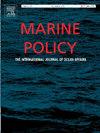Fine-scale mapping of ocean user groups to support species and habitat spatial management
IF 3.5
2区 社会学
Q2 ENVIRONMENTAL STUDIES
引用次数: 0
Abstract
Context
Maritime vessel activity is pervasive in the world’s oceans causing detrimental impacts on marine ecosystems. The management and monitoring of vessel activity has historically been focused on industrial vessels, however, and is often conducted only at large spatial scales and coarse resolutions. A more holistic approach is needed to understand where and when different maritime fleets are impacting the marine environment, particularly within protected areas.
Aims and methods
Here we explore fine-scale (50 m2) spatiotemporal patterns of multi-fleet vessel activity using Satellite Automatic Identification System (S-AIS) data over a two-year period (2018 – 2019) within a network of marine protected areas (MPAs) and their conservation features, using the biologically distinct oceanic archipelago of the Isles of Scilly (UK) as a case study.
Key results
Vessel activity was widespread, affecting over 87 % of the study area. However, high-intensity activity was concentrated along key transit and shipping routes. Recreational and passenger vessels posed the greatest pressure within MPAs, particularly on conservation-critical features like European shag habitats and seagrass beds. Seagrass beds faced additional pressures from anchoring and mooring, with impact pressure up to four times higher than in other habitats.
Conclusions
These findings reveal the complexity of mapping vessel impacts within MPAs and underscore the value of high-resolution analyses. Further research is needed to understand the in-situ effects on marine communities, particularly in high-pressure areas. Ignoring these cumulative impacts in monitoring strategies may compromise the effectiveness of MPAs in achieving their conservation goals.
求助全文
约1分钟内获得全文
求助全文
来源期刊

Marine Policy
Multiple-
CiteScore
7.60
自引率
13.20%
发文量
428
期刊介绍:
Marine Policy is the leading journal of ocean policy studies. It offers researchers, analysts and policy makers a unique combination of analyses in the principal social science disciplines relevant to the formulation of marine policy. Major articles are contributed by specialists in marine affairs, including marine economists and marine resource managers, political scientists, marine scientists, international lawyers, geographers and anthropologists. Drawing on their expertise and research, the journal covers: international, regional and national marine policies; institutional arrangements for the management and regulation of marine activities, including fisheries and shipping; conflict resolution; marine pollution and environment; conservation and use of marine resources. Regular features of Marine Policy include research reports, conference reports and reports on current developments to keep readers up-to-date with the latest developments and research in ocean affairs.
 求助内容:
求助内容: 应助结果提醒方式:
应助结果提醒方式:


